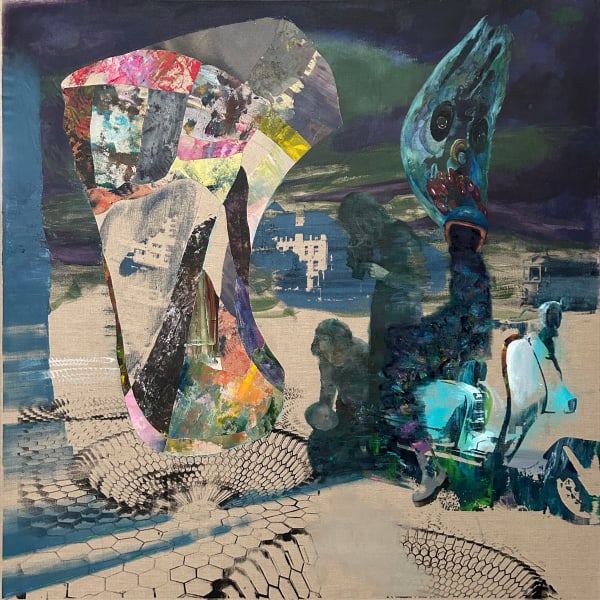-
-
Greg Creek: Paintings comprises a suite of new large-scale paintings that embody Creek's ongoing interest in issues of history, politics, identity and the everyday, and the connections between these distinct realms and registers. These complex paintings combine abstract and representational elements (key imagery is taken from Creek's own photographs) and various painting techniques to provide commentary and reflection of this fraught, complex contemporary moment.
Greg Creek's practice over the past 30 years has represented a political perspective on personal and public histories - engaging narrative, allegory and satire in large painting, drawing and installation projects. Described as 'one of Melbourne's most complex and demanding artists', Creek's practice poses compelling questions about art history, politics, aesthetics and, not least, the question that perpetually hovers over art making today: the relevance of painting as a medium for contemporary practice.
Creek is perhaps most well known for his large scale allegorical and history paintings, which includes Ha Ha–Theatre painting presented here, while large desktop works - begun as the throw away blotting sheets for his oil paintings - have since become a focus of his practice, significant in their own right. Creek uses a range of different graphic styles and mediums: representational and abstract rendered drawings, watercolours, diagrams, notations from everyday life and collage among so many others, sometimes applied to cut canvases. Creek's works often incorporate aspects of the working process such as spills and stains and, much as Creek constructs the works themselves, this excess of information begins to form an idiosyncratic, philosophical narrative.
-
Zilverster is an ongoing collaborative project, established in 2010 by Sharon Goodwin and Irene Hanenbergh; Melbourne-based artists renowned for their imaginative, elaborate and meticulously rendered solo practices. What began in 2010 as a problem-solving exercise—with one artist offering problematic, unfinished works to the other for advice on resolution—has evolved into a rich shared practice that continues to extend the discursive as well as process potentialities of each artist.
While there are many shared interests and concerns between the two artists—fantasy, (art) history, cult iconography, alchemy, supernatural phenomena to name just a few—each operates from a distinct temporal and imaginative framework: Goodwin's contributions are embedded in a medieval, Gothic context while Hanenbergh's derive from a European Romantic sensibility. Zilverster's practice continues to develop out from an original series of beautiful, fantastical drawings that remain compelling in their strangeness.
For štelo-stelo – which has multiple, overlapping meanings in Esperanto, including star, money and thief – Zilverster presents a suite of five of their hyper-meticulous style drawings together with a series of intricately engraved glass vessels. Esperanto scripts, ancient annotations, historic illustrations, pop-culture references and even corporate jargon materialise on the vessels. Alone, each object signifies a distinct message, but en masse their ambition becomes much more sinuous and complex; a visual code for the viewer to decipher.
-
AVAILABLE WORKS
Click on 'View more details' for pricing and further information. All prices inclusive of GST.-
 Greg Creek, Fraud-Garden Painting, 2024View more details
Greg Creek, Fraud-Garden Painting, 2024View more details -
 Greg Creek, Lubeck-Red Shift painting, 2024View more details
Greg Creek, Lubeck-Red Shift painting, 2024View more details -
 Greg Creek, Ha Ha-Theatre painting (triptych), 2023View more details
Greg Creek, Ha Ha-Theatre painting (triptych), 2023View more details -
 Greg Creek, Black-Egg painting, 2024View more details
Greg Creek, Black-Egg painting, 2024View more details
-
Greg Creek: Paintings and Zilverster: štelo-stelo
Past viewing_room












